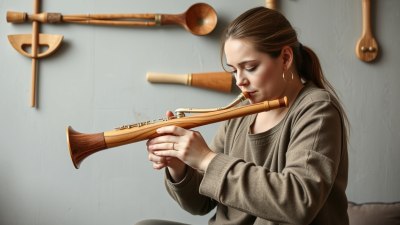Learning to Make Local Wind Instruments in Workshops
Discover the art of creating local wind instruments in workshops designed for all skill levels.

Image created with Flux Schnell
Wind instruments have been an integral part of human culture for centuries, resonating with the natural sounds of the environment. From simple flutes carved from wood to complex instruments like the saxophone, the evolution of wind instruments reflects the creativity and craftsmanship of various cultures. In this article, we delve into the fascinating world of local wind instrument workshops, exploring the joy of making your own instruments, understanding their history, and connecting with community through music.
The Significance of Wind Instruments
Wind instruments produce sound when air is blown into or across them, creating vibrations in the air column within the instrument. They encompass a wide range of musical devices, including flutes, clarinets, trumpets, and many more. Each type has unique characteristics, shapes, and sizes, contributing to the rich tapestry of music across different cultures. Learning to make wind instruments can deepen our appreciation for music and the artistic endeavors behind it.
Workshop Overview
Workshops dedicated to creating wind instruments provide participants with hands-on experience, teaching the necessary skills to craft their own instruments. These workshops often cater to all skill levels, from beginners to advanced artisans. They typically focus on locally sourced materials, allowing participants to connect with their environment and learn about sustainable practices in instrument crafting.
Types of Wind Instruments You Can Make
In workshops, participants may have the opportunity to create various types of wind instruments. Here are some examples:
- Flutes: Simple and captivating, flutes can be made from bamboo or other woods. Learning to carve and tune a flute is a rewarding experience.
- Didgeridoos: This ancient Australian instrument is made from eucalyptus trees. Workshops may provide guidance on the traditional methods of crafting didgeridoos.
- Harmonicas: A compact and versatile instrument, harmonicas can be assembled in workshops using pre-made reeds and combs.
- Pipes: Simple wind pipes can be created from materials like PVC, bamboo, or metal, making them accessible and fun to craft.
Benefits of Attending Workshops
Participating in local wind instrument workshops offers numerous benefits:
- Hands-On Learning: Workshops provide practical experience under the guidance of experienced instructors, allowing you to learn the craft effectively.
- Community Connection: Joining a workshop fosters a sense of community among participants, encouraging collaboration and shared creativity.
- Personal Expression: Crafting a musical instrument allows for personal expression, as you can customize the design, materials, and sound.
- Sustainability: By using local materials and teaching sustainable practices, workshops promote eco-friendly crafting.
What to Expect in a Workshop
While each workshop may differ in focus and structure, several common elements exist:
- Materials and Tools: Participants will usually be provided with the necessary materials and tools, including wood, adhesives, and finishing products.
- Instruction: Skilled instructors guide participants through the process, explaining techniques for carving, assembling, and tuning instruments.
- Sound Exploration: Participants typically have the opportunity to experiment with their instruments, exploring different sounds and refining their craft.
- Final Performance: Some workshops may culminate in a group performance, allowing participants to showcase their newly crafted instruments.
Choosing the Right Workshop
Finding the right workshop can enhance your learning experience. Here are some tips to consider:
- Research: Look for workshops that focus on the specific type of instrument you wish to make. Reading reviews and testimonials can provide insights into the quality of instruction.
- Instructor Credentials: Ensure that the instructor has experience and expertise in the type of wind instrument you are interested in.
- Location and Convenience: Choose a workshop that is accessible to you, keeping in mind travel costs and time commitments.
- Group Size: Smaller groups often lead to more personalized instruction, so consider the size of the workshop.
Tips for Success
If you're new to crafting wind instruments, here are some tips to make the most of your experience:
- Be Open-Minded: Embrace the learning process and be open to trying new techniques. Mistakes can lead to innovation!
- Practice Patience: Crafting an instrument takes time and patience. Allow yourself the space to learn and improve.
- Engage with Others: Collaborate with fellow participants for inspiration and support. Sharing ideas can enhance creativity.
- Enjoy the Journey: Focus on the fun of creating. The sounds you produce will be even more rewarding knowing you made the instruments yourself.
The Cultural Aspects of Wind Instruments
Wind instruments are not merely musical tools; they hold cultural significance in many societies. For instance, Native American flute music is deeply spiritual and often used in ceremonies, while the shakuhachi flute of Japan has historical ties to Zen Buddhism. By participating in wind instrument workshops, crafters can appreciate the cultural heritage behind the instruments they create and play.
As digital music continues to dominate, the love for handcrafted instruments remains strong. Workshops fostering traditional craftsmanship capture the attention of those seeking a deeper connection to music. With renewed interest in sustainability and local materials, wind instrument workshops are likely to grow in popularity, allowing new generations to experience the joy of making music.
The Joy of Music
Ultimately, creating your own wind instrument is about the joy of music. From the first sound produced to the intricate melodies crafted over time, the experience is one of personal and communal expression. So whether you’re a seasoned musician or a curious beginner, explore the world of wind instruments and join a workshop near you. Unleash your creativity, foster connections, and celebrate the music that lies within you.











